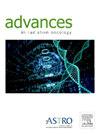3D Echocardiographic Phenotyping of Left Ventricular Mechanics and Function With Contemporary Radiation Therapy
IF 2.7
Q3 ONCOLOGY
引用次数: 0
Abstract
Purpose
Our objective was to characterize the early changes in cardiac function after thoracic radiation therapy (RT) using 3D echocardiography.
Methods and Materials
In a prospective longitudinal cohort study of 69 patients with breast cancer, lung cancer, or mediastinal lymphoma treated with chemotherapy and RT, clinical and 3D echocardiographic data were assessed before, immediately after, and 5 to 9 months after RT completion. 3D left ventricular ejection fraction, global circumferential strain, global longitudinal strain (GLS), average 3D strain, twist, and torsion were quantified. Associations among mean heart dose (MHD), V5, and V30 and early changes in echocardiography-derived measures of cardiac function were assessed with generalized estimating equations.
Results
The median (quartile 1, quartile 3) estimates of MHD ranged from 1.2 Gy (1.0-1.9) in patients with breast cancer (n = 39), to 6.8 Gy (4.0-12.5) in patients with mediastinal lymphoma (n = 17), and 19.4 Gy (11.3-21.7) in patients with lung cancer (n = 13). There were no significant changes in 3D echocardiography measures in patients with breast cancer over time. However, in patients with lung cancer/lymphoma, there was a worsening in 3D left ventricular ejection fraction, GLS, and average 3D strain from pre-RT to RT completion (P < .05). This worsening in 3D GLS persisted at 5 to 9 months (P < .05). Across the entire cohort, MHD, V5, and V30 were not associated with changes in global 3D echocardiography-derived measures (P > .05).
Conclusions
Early abnormalities in cardiac function as measured by 3D echocardiography can be detected following RT. Additional work is needed to define the determinants of changes in cardiac function with RT and long-term impact of early changes on clinical outcomes.
当代放射治疗下左心室力学和功能的三维超声心动图表型分析
目的:利用三维超声心动图分析胸部放射治疗(RT)后心功能的早期变化。方法和材料在一项前瞻性纵向队列研究中,对69例接受化疗和放射治疗的乳腺癌、肺癌或纵隔淋巴瘤患者进行了临床和3D超声心动图数据评估,在放射治疗完成之前、之后以及完成后5至9个月。量化左心室三维射血分数、整体周向应变、整体纵向应变(GLS)、平均三维应变、扭转和扭转。用广义估计方程评估平均心脏剂量(MHD)、V5和V30与超声心动图衍生的心功能测量的早期变化之间的关系。结果乳腺癌患者(n = 39)的MHD中位数(四分位数1和四分位数3)为1.2 Gy(1.0-1.9),纵隔淋巴瘤患者(n = 17)为6.8 Gy(4.0-12.5),肺癌患者(n = 13)为19.4 Gy(11.3-21.7)。随着时间的推移,乳腺癌患者的三维超声心动图测量没有明显变化。然而,在肺癌/淋巴瘤患者中,3D左心室射血分数、GLS和平均3D应变从放疗前到放疗完成有恶化(P <;. 05)。3D GLS的恶化持续5 - 9个月(P <;. 05)。在整个队列中,MHD、V5和V30与总体三维超声心动图衍生测量的变化无关(P >;. 05)。结论通过三维超声心动图可以检测到RT术后心功能的早期异常,需要进一步的工作来确定RT术后心功能变化的决定因素以及早期变化对临床结果的长期影响。
本文章由计算机程序翻译,如有差异,请以英文原文为准。
求助全文
约1分钟内获得全文
求助全文
来源期刊

Advances in Radiation Oncology
Medicine-Radiology, Nuclear Medicine and Imaging
CiteScore
4.60
自引率
4.30%
发文量
208
审稿时长
98 days
期刊介绍:
The purpose of Advances is to provide information for clinicians who use radiation therapy by publishing: Clinical trial reports and reanalyses. Basic science original reports. Manuscripts examining health services research, comparative and cost effectiveness research, and systematic reviews. Case reports documenting unusual problems and solutions. High quality multi and single institutional series, as well as other novel retrospective hypothesis generating series. Timely critical reviews on important topics in radiation oncology, such as side effects. Articles reporting the natural history of disease and patterns of failure, particularly as they relate to treatment volume delineation. Articles on safety and quality in radiation therapy. Essays on clinical experience. Articles on practice transformation in radiation oncology, in particular: Aspects of health policy that may impact the future practice of radiation oncology. How information technology, such as data analytics and systems innovations, will change radiation oncology practice. Articles on imaging as they relate to radiation therapy treatment.
 求助内容:
求助内容: 应助结果提醒方式:
应助结果提醒方式:


